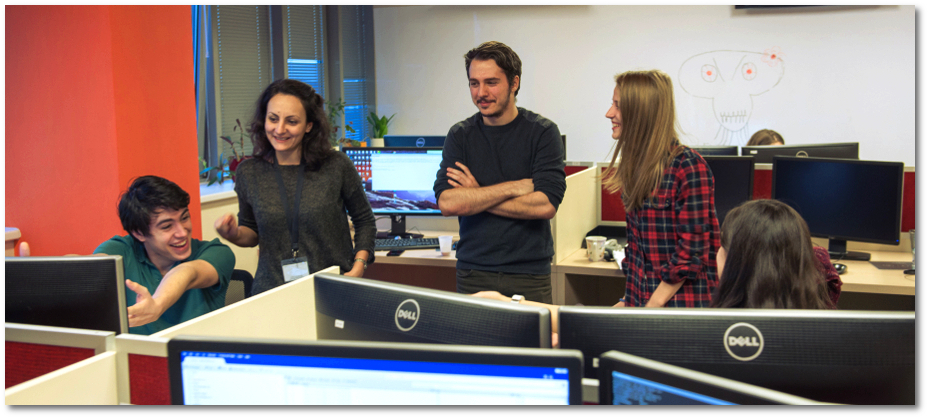Last week was all about summer and students for us, as we kicked off our 9th internship program. We were very happy to meet a new generation of brilliant future computer engineers at the LSAC IT&C Job Fair and to showcase our Cool Summer Internship. The participants got the chance to interact with our team and our CEO, find out more about us, what we’re working on and what it takes to become one of our Clouders.
Posts in Category: clouders
Every March, excitement takes over our office. Everyone gets giddy and it’s quite clear we’re just counting down the days ’till a new edition of Cool Summer Internship! This is the exact situation we’re in right now, so let’s take a closer look at what we have in store for this year 🙂
Let’s meet
We’re debuting our 8th internship program during the LSAC IT&C Job Fair today. We’re welcoming brilliant future engineers to our presentation at the Automation and Computers Faculty. Let’s meet in EC105 hall starting 2 PM. This is a great opportunity for all students to find out more about us, what we’re working on and what it takes to become one of our Clouders. Both our CEO, Bogdan Carstoiu, and our newest Clouders will have interesting stories to share.

Photo by Samuel Zeller on Unsplash
The amount of time spent on mobile apps has increased by 21% from 2014 to 2015, with the mobile app market being worth an estimated $58 billion. That amount will rise to $77 billion by 2017, according to research conducted this year. But it’s not the mobile apps themselves that generate all this money – it’s the services behind them.
At the dawn of the app store gold rush – as the media affectionately calls it – apps were low in numbers and simplistic: reminders, photography, note taking, doodling apps, match-three games etc. As time progressed, not only were there more apps to be found, but their complexity grew as well, and so did the hardware they ran on. Their numbers grew from mere thousands to billions, as more developers started leveraging newer, more advanced technology, but also another game changer

Photo by Jonathan Simcoe on Unsplash
Success in business depends as much on innovation as it does on adaptability, strategy, marketing, and of course solid investments. The evidence in favor of digital investments as a key driver is overwhelming. In the not too distant future, a company’s communication and collaboration efforts will be inherently reliant on cloud technology. And the reason is simple: everybody’s doing it, and he who doesn’t falls behind in reach, discoverability, customer satisfaction and many other areas that make or break a business.
Fierce competition, but also the always-on nature of cloud solutions, forcefully dictate the need to incorporate technology as a business strategy. Research conducted by IDG Enterprise gives us a bird’s eye view of the direction of spending, areas of investment and drivers, with a focus on the communication tools employed (or soon-to-be-employed) at large companies
Photo by rawpixel on Unsplash
Sales, marketing, consulting… these are paid positions that society finds useful in many contexts, but the world and its future are not dependent on these occupations. Engineering, however, is something the world cannot do without.
Engineering can be considered the world’s oldest profession because it predates humanity. Just ask Charles Darwin, whose famous theory of evolution is based on the idea that nature constantly engineers itself to survive and adapt. Bruce Dickinson surely agrees. According to the famous rocker, engineering is one of the most important things you can teach a child to aspire to

Photo by Alberto Tolentino on Unsplash
A friendly interface goes a long way, but building software with the entire User Experience (UX) in mind helps achieve a more straightforward path to the ultimate goal of usability. Researchers at Brigham Young University want to open a new chapter in UX by determining exactly what people are feeling when they are sitting in front of their computers – all through mouse movement interpretation.
The research, Inferring Negative Emotion from Mouse Cursor Movements, reveals how “attention control theory” can leverage our trusty point-and-click devices as real-time indicators of negative emotions. When people experience anger or frustration
The date is December 18. The year 2015. And Verb Days is back in the house!
We’re live from Verb Days 4.0, the fourth edition of our annual hackathon. Five teams brimming with coding badassery and creative prowess are about to duke it out in the open space area of our HQ. This year’s mission? Give birth to a brand new and exciting integration with Hubgets, our teamwork app. As part of this year’s contest, we’re not just having fun, we are also making Hubgets a better collaboration tool for every user.
The main evaluation criteria for each project remains unchanged. Innovation will count the most, while each team will have to pick a member who doesn’t fumble with words to give a presentation of their brainchild. If we’re going to offer it publicly, we’ll have to be the first to like it.
Let the hacking (and the liveblogging) begin!
On your marks…
get set…..
CODE!

Photo by Carsten on Unsplash
Eddington’s Arrow of Time – describing the one-way direction (or asymmetry) of time – says that things in the real world can never be fully reversed. Unlike in the microscopic world, where things tend to behave a little differently, our world is governed by an obvious flow of time.
A drop of ink can instantly spoil an entire glass of water. Reversing the process would take far more energy and resources than it took to cause it, not to mention more time. The obvious solution
Sitting on the edge of your seat, shaking with anticipation as theaters everywhere get ready to premiere Star Wars: The Force Awakens next week? So are we. Don’t worry, your symptoms are normal. That’s what Sci-Fi does to a person.
During lunch break the other day, we wanted to settle an argument about the might of Galactic Federation ships versus those of The Empire. No one really knew for sure just how big these things were until we happened upon this amazing infographic by Dirk Loechel. We decided to share it with the rest of the class so everyone can brush up on their general Sci-Fi knowledge as we tick the days on our calendars. You know, just in case any other debates ensue as we sit in line at the cinema.

Photo by Gabriele Motter on Unsplash

Photo by Mika Baumeister on Unsplash
The say the future of business is in the cloud. 72% of organizations today have at least one application in the cloud, and spending in this area continues to be on the rise. Cost efficiency, agility and speed to-market are just some of the undeniable advantages that cloud computing services have to offer. But there is another “big” area of interest that’s about to become one of the largest business opportunities of the century.
Big data is the new oil according to Jer Thorp, co-founder of the Office for Creative Research, a multi-disciplinary research group. And according to Foursquare’s Andreq Hogue, for every two degrees that go up, check-ins at ice cream shops also go up by 2%. That’s the power of









